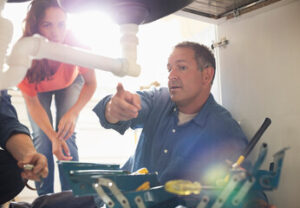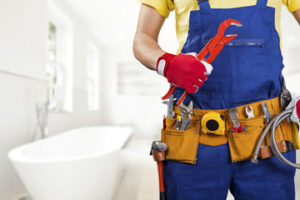Plumbing is a complex system that serves multiple purposes like distributing water, removing waste, and heating/cooling facilities. It’s an industry that involves constant innovation and change to accommodate new technologies, skills, and customer demands.

Moreover, plumbers enjoy the flexibility of setting their own schedule and working as freelancers. However, they must remain aware of state-specific regulations and continuing education requirements to maintain their license. Contact Plumbing Lexington KY for professional help.
The plumbing industry has come a long way since its ancient roots. Today, it’s hard to imagine living without it. Here is a look back at the important events that have shaped modern plumbing.
The earliest plumbing systems were developed by ancient civilizations like the Romans, Greeks and Egyptians, who needed to provide public baths and toilets for their citizens. The Romans were credited with many of the early innovations in plumbing, including building impressive aqueducts that transported water from rivers and lakes into their cities.
In the 16th century, plumber began using cast iron pipes and designing water closets. These innovations were the first of their kind, allowing for the proper disposal of waste and increasing sanitation in cities and towns. This was a huge improvement over previous methods such as open ditches and cesspools.
In addition to these important developments, modern plumbing has also been shaped by material changes and environmental factors. For instance, galvanized steel pipes were popular in the United States from the late 1800s until the 1960s when copper took over. Then, during World War II, iron and steel became scarce so plumbing manufacturers started to use plastics. Afterwards, conservation laws were introduced, and it is now against the law to flush more than 3.5 gallons of water per minute.
To become a plumber, you need a high school diploma or equivalent and to undergo training through a vocational or technical school. These programs teach you the basics of plumbing and give you the hands-on experience you need to work with tools and materials. After graduating, you can pursue an apprenticeship. These can last anywhere from two to five years and will cover all aspects of the trade. After completing an apprenticeship, you will be ready to start your career as a plumber.
Valves and Pipes
Valves are one of the most important components of a plumbing system. They help to regulate water flow and pressure in a safe and effective manner. There are many different types of valves, each with its own specific functions. Valves are constructed from a variety of materials, including metals that are able to withstand high temperatures and pressure. Those that are used in underground environments may also be made from plastics for added strength and resistance to corrosion.
Pipes without valves would not be able to transport water or other fluids to and from appliances and fixtures. The valves are what allow the pipes to operate correctly, ensuring that there is an adequate amount of pressure in the system at any given time. They are also responsible for maintaining appropriate temperatures in the piping systems. Valves can be manually operated or automated, and can be actuated via an electric, pneumatic/air, hydraulic or solenoids system.
Some of the most common types of valves include pressure relief valves, ball valves, gate valves and check valves. Pressure relief valves work to relieve the excess pressure in a pipe, which can cause it to burst. They have a spring and diaphragm mechanism that can be set to limit the amount of water pressure in the pipes.
Ball valves and gate valves work by using a disc to block or allow the flow of water through them. The valve disc is attached to a stem and bore inside the pipe, which can be opened or closed by turning a handle. A gate valve, on the other hand, uses a disc that moves up and down through a spindle stem inside the pipe. This is accomplished by turning a knob at the top of the valve, which lifts or lowers the valve disc in the pipe to open and close it.
These types of valves are commonly used in residential settings for a wide range of tasks. Some of these tasks include regulating water flow, preventing backflow, and minimizing the risk of flooding. They are also useful in regulating temperature, as some of them come with built-in thermostats. The type of valve that is required for a particular task is determined by the needs of the piping system as a whole.
Plumbing and Piping
Piping is a system of pipes that transports liquids, gases and sometimes solids from one location to another within a structure. Its role is essential in industrial processes, such as oil and gas extraction, chemical manufacturing, water treatment and power generation. Without piping systems, it would not be possible to convey the vast amounts of oil and water necessary for modern life. Piping engineering is the discipline that studies the efficient design of piping systems.
There are many facets to the pipe-designing process, which requires the use of sophisticated software tools for fluid flow simulations. Piping engineers are also required to understand the principles of fluid mechanics, including the Continuity Principle and Bernoulli’s Equation. They must also take into account factors such as internal piping and valve loads, external environmental conditions, regulatory standards and cost.
The most common form of piping is found in the building industry, where it is used to carry water, natural gas, heating and cooling, and sewage. In fact, plumbing is so common that most people don’t realise that the term ‘piping’ is a specific field of engineering that encompasses a range of different industrial applications.
Pipes are constructed of a variety of materials, including copper, steel and aluminium. They can be welded, forged or cast. Other components of a piping system include flanges, fittings and valves. Valves are used to control and regulate the flow of fluids, while flanges connect the piping segments. Fittings are devices that link piping and alter their direction or shape, such as elbow joints, tees and reducers.
A piping system can also incorporate instrumentation and controls, which are often part of an industrial process. These can sense and measure the pressure, temperature and flow rate of fluids, and automatically control them. The piping and instrumentation diagram (P&ID) is the key document for describing these piping systems.
Piping design challenges include layout and routing, which involves determining the most efficient paths for fluid to travel while avoiding clashes with other equipment or structures. The piping engineer must also perform a stress analysis to ensure that the pipes can withstand operational and environmental stresses. They must also prepare piping isometrics mark-ups and specifications and coordinate with the structural engineering group to confirm support locations and loads.
Plumbing in Commercial Buildings
Plumbing in commercial buildings is different from plumbing in homes, although the basics are similar. Both involve piping to bring in clean water and get rid of wastewater, but the systems are typically larger and more complex in commercial settings. This type of plumbing is used in spaces like office buildings, strip malls, warehouses, and hospitals. Commercial plumbers work on these systems to ensure they are functioning properly.
Plumbing problems are more likely to occur in commercial settings, since there is a greater volume of water and waste being used daily. For example, in a large office building, hundreds of people might be using the same toilets, sinks, and drinking fountains on a regular basis, whereas home plumbing systems usually have only a few occupants. This means that there is a higher risk of damage to the pipes and fixtures, and it also takes longer for issues to be noticed and fixed.
In addition, many commercial properties must follow strict health and sanitation laws, which place additional demands on the plumbing system. For instance, restaurants need to have grease traps that are regularly cleaned and emptied to prevent blockages and keep the drains running smoothly.
Another issue that can affect commercial plumbing is that it is often harder to identify the source of a leak or other problem, as there are more pipes in larger facilities. For example, in a high-rise building, it can be difficult to determine where a leak is coming from in the ceiling. This can lead to significant water wastage and expensive repairs.
Because of the unique challenges that come with commercial plumbing, it is important to have a team of professionals on hand to handle maintenance and repairs as needed. In addition to commercial plumbers, these teams should include experienced building engineers and skilled property managers. These individuals can help to manage the complexities of a large building’s plumbing system, and they can also make recommendations on how to improve efficiency and reduce costs. They can also assist with ensuring that the plumbing system meets all necessary codes and compliance regulations.
